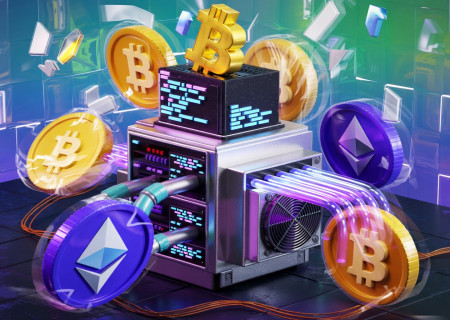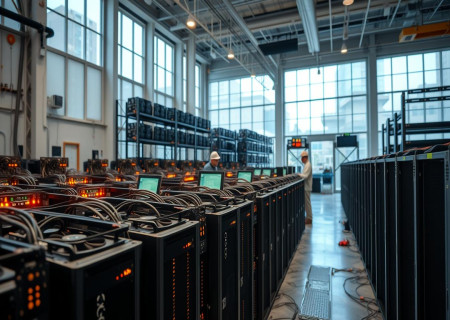
- January 7, 2025
- 11 months ago
Low-Cost Bitcoin Mining Pools in 2025 – Reliable Choices for Miners
The cryptocurrency landscape never stands still, and Bitcoin mining continues to play a pivotal role in this dynamic field. For miners in 2025, finding a trustworthy mining pool with reasonable fees is essential for maximizing profits.
A Bitcoin mining pool is essentially a collaborative effort where miners work together to solve complex computational problems. By joining forces, they increase their odds of earning rewards. However, with so many options available, choosing the right low-fee pool can be a game-changer for your mining success.
This blog will explore the top low-fee Bitcoin mining pools of 2025. We’ll discuss their features, advantages, and what makes each a compelling choice.
Bitcoin Mining Pools in 2025
Bitcoin mining pools remain integral to the cryptocurrency ecosystem in 2025. They have revolutionized how miners validate transactions and earn rewards while fostering collaboration between individual miners and mining groups.
What Are Bitcoin Mining Pools?
A Bitcoin mining pool is a collective of miners who work together using their computational power to verify Bitcoin transactions. By pooling resources, the group achieves more consistent rewards compared to individual mining efforts. A central operator manages the pool, ensuring tasks and rewards are distributed fairly.
Why Join a Mining Pool?
Mining solo can lead to sporadic and unpredictable payouts. While you might earn a significant reward alone, the time it takes to achieve it can be discouraging. Mining in a pool provides smaller but regular income, making it a popular option for those seeking stability.
Below is a comparison to help you understand the differences:
| Feature | Solo Mining | Mining Pool |
|---|---|---|
| Reward Distribution | Rare, large payouts | Frequent, smaller payouts |
| Income Stability | High variance | Low variance |
| Community Support | Limited | Strong community |
Why Fees Matter in Bitcoin Mining
Fees are a critical factor in Bitcoin mining profitability. Even minor fee reductions can significantly boost your earnings. Miners operate in a competitive environment, where every cost-saving advantage counts. Pools with favorable fee structures are especially appealing because they allow miners to retain a larger share of their rewards.
How Mining Pool Fees Impact Your Profitability
Lower fees translate to higher net earnings. The cost structure of a mining pool significantly influences miners’ decisions about which pool to join. Pools with a low-fee policy typically draw more participants, offering better earning opportunities collectively.
Pool Fee Structures Explained
Bitcoin mining pools employ several types of fee structures, each catering to different priorities:
- Pay Per Share (PPS)
PPS ensures steady payouts by rewarding miners for each share they contribute, but it comes with higher fees. - Pay Per Last N Shares (PPLNS)
PPLNS focuses on rewarding miners for shares during a defined period, often resulting in lower fees but less predictable payouts. - Full Pay Per Share (FPPS)
FPPS combines the steady payments of PPS with transaction fee rewards, offering miners a middle ground of predictability and profit.
Key Factors When Selecting a Mining Pool
To make the most out of Bitcoin mining, consider these key criteria when evaluating mining pools:
Fees and Fee Structures
Some pools charge a percentage of your rewards, while others have flat fees per block. For example, a pool charging 2% on rewards might be more approachable than one with a complicated, fluctuating fee rate. Always compare what’s on offer to find the best fit.
Pool Hashrate and Stability
Hashrate determines how often a pool can find blocks and collect rewards. A stable pool with ample processing power is more likely to maintain consistent payouts. Research a pool’s historical uptime and reliability metrics to assess its overall performance.
Payout Rules
Think about payout thresholds and frequency. Pools with lower thresholds or faster payout cycles can benefit miners in need of regular earnings.
Server Locations
The geographical placement of a pool’s servers can impact latency. Pools with global server distributions often offer better performance, particularly for miners located far from major hubs.
| Criteria | Description | Importance |
|---|---|---|
| Fee Percentage | Direct effect on mining profitability | High |
| Pool Hashrate | Determines consistency of rewards | High |
| Payout Thresholds | Influences frequency of earnings | Medium |
| Server Locations | Impacts mining connection latency | Medium |
Evaluating Pool Trustworthiness
Trust is paramount when choosing a mining pool. Here’s how to gauge a pool’s reliability:
- Transparency
A pool that openly communicates its fees, hashrates, and reward structures fosters confidence among its miners. - Historical Performance
Past records of consistent uptime and payouts can signal reliability. Review available data on the pool’s operations. - User Feedback
Community opinions on forums and social media often shed light on a pool’s reputation.
Top Low-Fee Bitcoin Mining Pools of 2025
Here’s a snapshot of four standout low-fee pools in 2025:
F2Pool
Known for its low fees and high reliability.
- Fee Rate: 2%
- Uptime: 99.9%
Antpool
Popular for its technological services and industry expertise.
- Fee Rate: 2%
- Uptime: 99.8%
Foundry USA
Boasting ultra-low fees and innovative practices.
- Fee Rate: 0.5%
- Uptime: 99.7%
Binance Pool
Backed by the Binance name, offering accessible and user-friendly services.
- Fee Rate: 2.5%
- Uptime: 99.6%
Steps for Joining a Mining Pool
Here’s how to get started:
- Set Up Your Hardware
Choose a reliable ASIC miner and ensure it’s properly configured with cooling and power systems. - Create an Account
Register with your chosen mining pool, ensuring you provide a secure wallet address for rewards. - Configure Mining Software
Download a compatible mining software and input the pool’s details to begin operations. - Monitor Performance
Use monitoring tools to track your mining progress and make necessary adjustments.
Common Challenges in Bitcoin Mining
Even experienced miners face hurdles. Learn to overcome common issues:
- Connection Failures
Check network settings and ensure firewalls are configured correctly. - Late Payouts
Confirm you’ve met the pool’s payout threshold and that your wallet information is accurate. - Low Hash Rate
Maintain hardware efficiency and optimize software settings to improve your performance.
Emerging Trends in 2025
Two major trends will reshape the mining pool industry in 2025:
- Decentralized Pools
These pools remove central control, using blockchain systems to create fairer and more resilient mining networks. - Sustainability Initiatives
Pools are now adopting renewable energy sources and more efficient hardware to reduce their environmental footprint.
| Initiative | Description |
|---|---|
| Renewable Energy | Transitioning to solar, wind, or hydro power |
| Energy Efficiency | Improving cooling technologies |
Final Thoughts
Bitcoin mining remains a competitive yet rewarding venture. Finding a low-fee, dependable mining pool is critical to ensure your efforts are both profitable and secure. Stay informed about trends like decentralization and sustainable practices to align with the future.
Make smart decisions, and you’ll not only boost your income but also remain ahead in the ever-evolving mining space.
FAQs
- What is a Bitcoin mining pool?
It’s a group of miners collaborating to validate transactions and share rewards. - Why prioritize low-fee pools?
Low fees maximize your earnings by reducing overhead costs. - What trends are shaping mining in 2025?
Decentralized networks and eco-friendly initiatives are leading the way.




